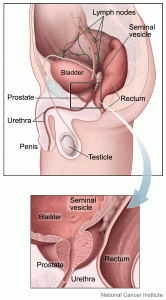What is the prostate?
The prostate is an organ that lies below the bladder in men (See Figure 1). It is relevant because:
- It is a gland, meaning it secretes various substances used for bodily function. About 30% of semen is secreted by cells within the prostate. These secretions are necessary for fertility.
- The remaining semen travels through the prostate during ejaculation.
- Urine exits the bladder via the urethra–a tube going from the bladder to the tip of the penis. Part of the urethra travels through the prostate.
- Nerves that contribute to erections and continence (keeping urine from leaking) travel alongside the prostate.

What is prostate cancer?
Prostate cancer refers to an abnormal growth formed by cells originating from the prostate. Prostate cancer is malignant, meaning that if it is left untreated it may continue to invade surrounding organs and spread to other parts of the body.
- The cancerous process starts when a single cell in the prostate starts to copy itself uncontrollably. Why this happens in the first place is often uncertain. Cancerous cells continue to multiply until they form a lump called a tumor. This tumor stays confined within the prostate at first. This is referred to as localized prostate cancer.
- If left untreated, this tumor eventually invades organs surrounding the prostate. Organs at risk of invasion may include the bladder, seminal vesicles, rectum, muscle and fat (See Figure 1). This is referred to as locally advanced prostate cancer.
- Eventually, cancer cells may also spread beyond the local area of the prostate. Prostate cancer tends to spread to the lymph nodes and bones. This process is called metastasis. This type of prostate cancer is metastatic prostate cancer.
Not every prostate cancer will progress through these stages. Some prostate cancers are not very aggressive and may never become a problem, while others present as metastatic prostate cancer. More information about the spectrum of prostate cancer is available on the diagnosis page.
How common is prostate cancer?
Prostate cancer is the most common cancer in Canadian men. In 2015, an estimated 24,000 Canadian men will be diagnosed with prostate cancer and an estimated 4,100 Canadian men will die from prostate cancer. The Canadian Cancer Society estimates that the lifetime risk of developing prostate cancer is 1 in 8. The number of men with undetected prostate cancer that will cause them no problems is undoubtedly much higher.
Source: Canadian Cancer Society
Who is at highest risk of prostate cancer?
Prostate cancer arises when changes in a prostate cell’s DNA (a DNA mutation) allows it to enter the cancerous process described above and multiply uncontrollably. This process is more likely to happen in some men due to a variety of risk factors. The main risk factors for prostate cancer include:
- Age is the most important risk factor for prostate cancer. A diagnosis of prostate cancer rarely occurs before the age of 40 and new cases are usually diagnosed in the 60-70 age group.
- African heritage is also a significant risk factor for developing prostate cancer.
- A susceptible genetic makeup is also a risk factor for prostate cancer. This is suggested when a patient has had multiple family members who have had prostate cancer. Certain genetic syndromes such as BRCA gene mutations are known to increase prostate cancer risk.
Additional endorsed web resources
National Cancer Institute Prostate Cancer Fact Sheet
Canadian Cancer Society Prostate Cancer Information
References
1. Guyton, A.C. and J.E. Hall, Textbook of medical physiology. 11th ed. 2006, Philadelphia: Elsevier Saunders. xxxv, 1116 p.
2. Delongchamps, N.B., A. Singh, and G.P. Haas, The role of prevalence in the diagnosis of prostate cancer. Cancer Control, 2006. 13(3): p. 158-68.
3. Hankey, B.F., et al., Cancer surveillance series: interpreting trends in prostate cancer–part I: Evidence of the effects of screening in recent prostate cancer incidence, mortality, and survival rates. J Natl Cancer Inst, 1999. 91(12): p. 1017-24.
4. Platz, E.A., et al., Racial variation in prostate cancer incidence and in hormonal system markers among male health professionals. J Natl Cancer Inst, 2000. 92(24): p. 2009-17.
5. Zeegers, M.P., A. Jellema, and H. Ostrer, Empiric risk of prostate carcinoma for relatives of patients with prostate carcinoma: a meta-analysis. Cancer, 2003. 97(8): p. 1894-903.